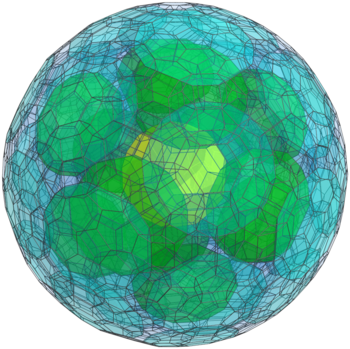The Cantitruncated 600-cell
The cantitruncated 600-cell is a beautiful uniform polychoron from the 120-cell/600-cell family. It is bounded by 1440 cells (120 truncated icosahedra, 720 pentagonal prisms, 600 truncated octahedra), 8640 polygons (3600 squares, 3600 hexagons, 1440 pentagons), 14400 edges, and 7200 vertices. It may be constructed from the bitruncated 120-cell by radially expanding the truncated icosahedral cells outwards and filling in the gaps with pentagonal prisms.
The above image shows a perspective projection of the cantitruncated 600-cell into 3D, centered on one of its 120 truncated icosahedral cells. The yellow truncated icosahedron in the center is the nearest cell to the 4D viewpoint. The green cells are 12 other truncated icosahedra separated from this nearest cell by pentagonal prisms, and the cyan cells are another layer of 32 truncated icosahedra. For clarity, we omit the cells that lie on the far side of the polytope, and show the prisms and truncated octahedra only in a light transparent color.
Structure
We shall explore the structure of the cantitruncated 600-cell by means of its parallel projection into 3D, centered on one of its truncated icosahedral cells.
First Layer
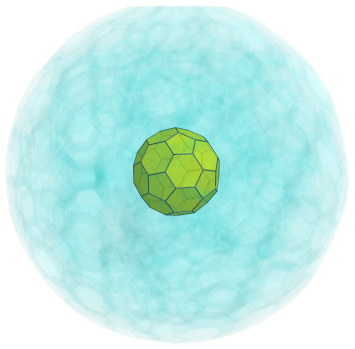
The above image shows the nearest truncated icosahedral cell to the 4D viewpoint. For clarity, we omit cells on the far side of the cantitruncated 600-cell and render the remaining cells in a light transparent color.
This truncated icosahedron may be regarded as the “north pole” cell of the cantitruncated 600-cell.
Second Layer
The 12 pentagonal faces of the nearest truncated icosahedron are shared with 12 pentagonal prisms:
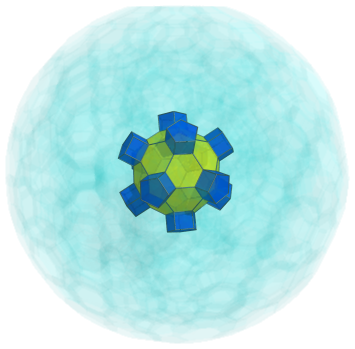
The 20 hexagonal faces of the truncated icosahedron are shared with 20 truncated octahedra, shown next:
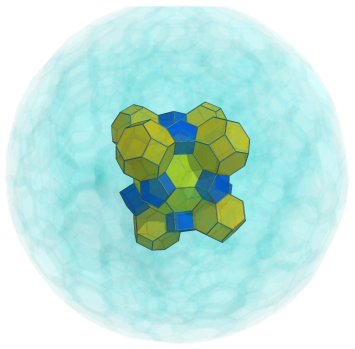
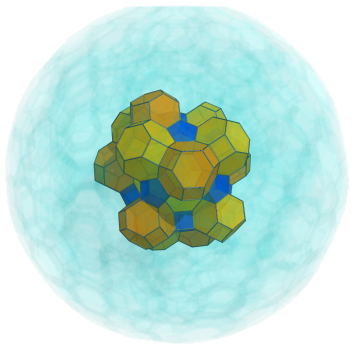
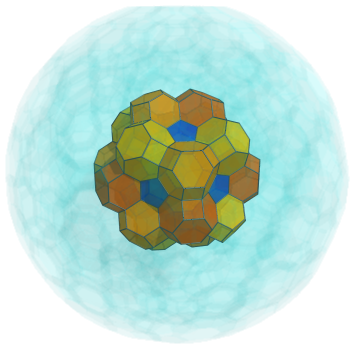
Third Layer
The exposed blue pentagonal faces of the pentagonal prisms are joined to another 12 truncated icosahedra:
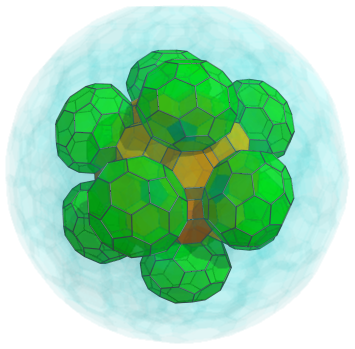
These truncated icosahedra are linked by 30 pentagonal prisms, shown below:
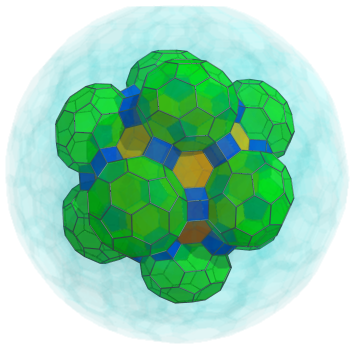
Another 20 truncated octahedra touch the exposed hexagonal faces of the previous group of 20 truncated octahedra:
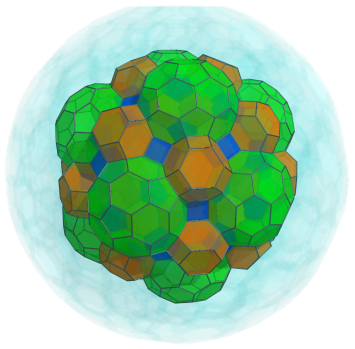
Fourth Layer
The exposed blue square faces of the pentagonal prisms from the third layer are shared with another 30 truncated octahedra:
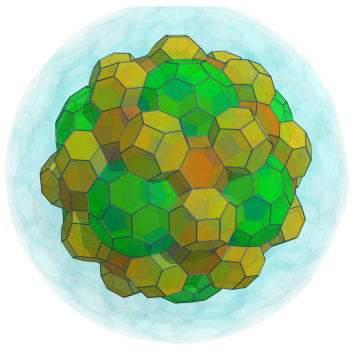
Nestled between these truncated octahedra are 60 more pentagonal prisms, in twelve circles of 5 pentagonal prisms each:
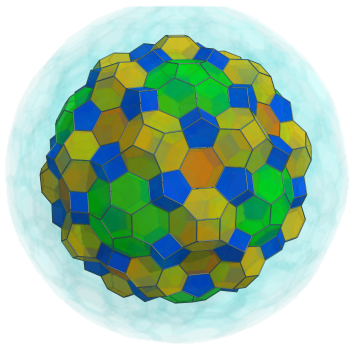
Another 12 pentagonal prisms cap the green truncated icosahedra:
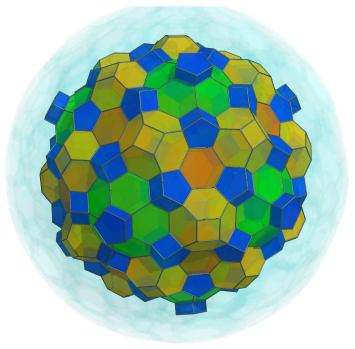
Overlying these pentagonal prisms are another 60 truncated octahedra:
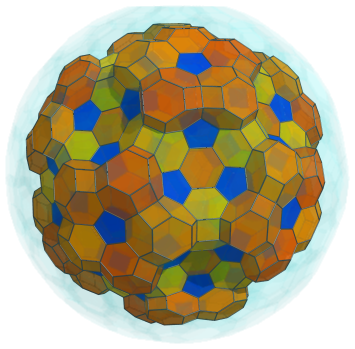
The bowl-shaped cavities gradually becoming visible here are filled by 20 truncated icosahedra:
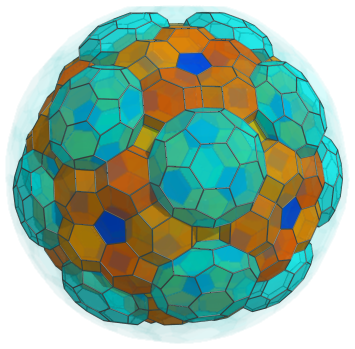
Straddled between these truncated icosahedra are another 30 pentagonal prisms:
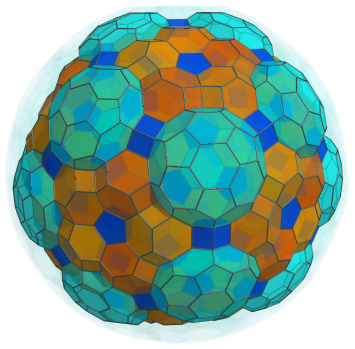
Fifth Layer
The pentagonal circles of truncated octahedra from the previous layer are, of course, where another 12 truncated icosahedral cells lie. These are shown next:
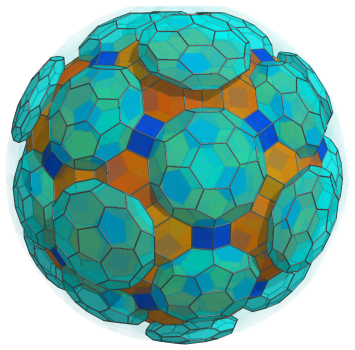
These cells are bridged to the previous truncated icosahedral cells by 60 pentagonal prisms:
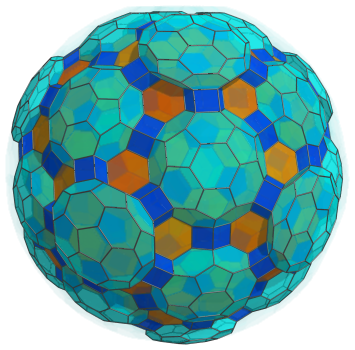
The remaining exposed hexagonal faces of the truncated octahedral cells from the previous layer are where another layer of 60 truncated octahedra lie:
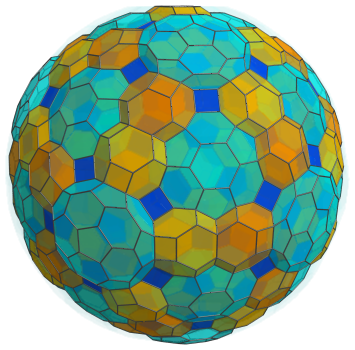
Yet another 60 truncated octahedra straddle these ones:
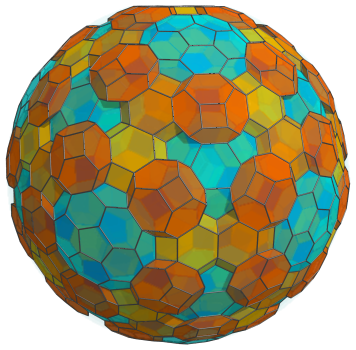
The obvious pentagonal prismic gaps around these cells are, obviously, filled in by more pentagonal prisms: 120 of them, 60 in twelve circles of 5 above 12 of the truncated icosahedra, and another 60 in 20 groups of three above the other 20 truncated icosahedra. The following image shows the first group of 60:
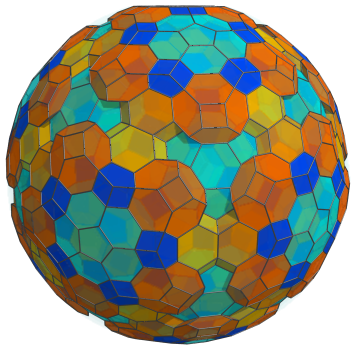
The next image adds the second group of 60:
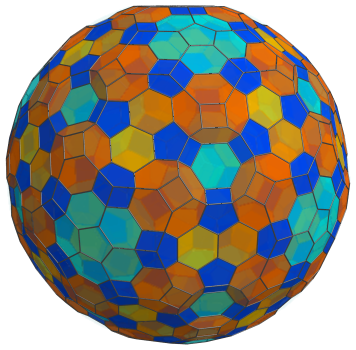
Finally, the remaining shallow depressions around the pentagonal prisms of the second group are filled in by 20 truncated octahedra:
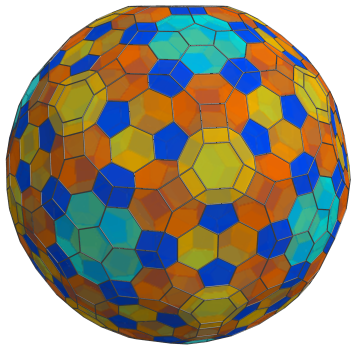
These are all the cells that lie on the “northern hemisphere” of the cantitruncated 600-cell.
The Equator
The “equator” of the cantitruncated 600-cell consists of the cells that lie at 90° to the 4D viewpoint of the parallel projection. Among them are 30 truncated icosahedra, as shown below:
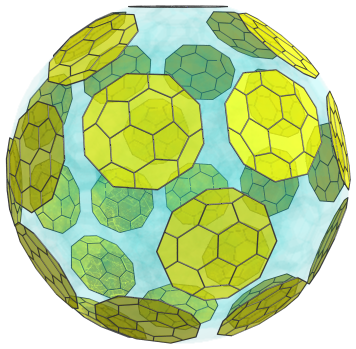
For clarity's sake, we omit the cells from the northern hemisphere that we have already seen above. Due to the 90° view angle, these cells have been foreshortened into decagons; but in 4D, they are perfectly uniform truncated icosahedra. They are linked to each other via pentagonal prisms:
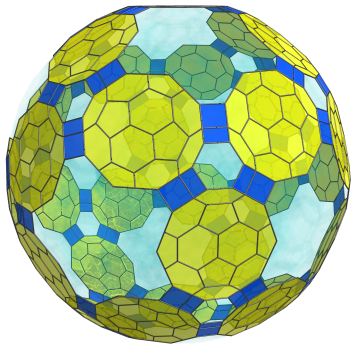
There are 60 pentagonal prisms here. They have been foreshortened into rectangles due to the 90° view angle. Another 12 pentagonal prisms lie on the equator, linking 12 truncated icosahedra from the northern hemisphere to their counterparts in the southern hemisphere:
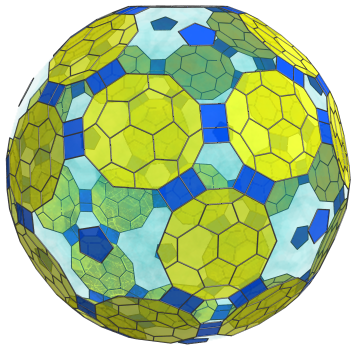
Unlike the previous pentagonal prisms, due to their different orientation, these ones have been foreshortened into pentagons. Both are perfectly uniform pentagonal prisms in 4D.
Surrounding these 12 pentagonal prisms are 60 truncated octahedra, shown next:
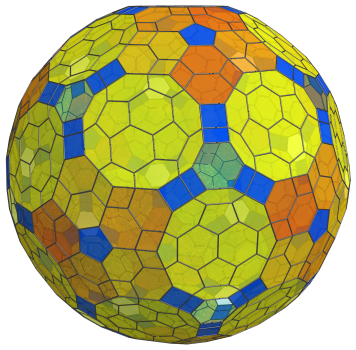
These are all the cells that lie on the equator of the cantitruncated 600-cell. There are 20 hexagonal gaps remaining: these are not projection images of any cell, but are where 20 truncated octahedra in the northern hemisphere touch their counterparts in the southern hemisphere.
Past this point, we reach the “southern hemisphere”, that is, the far side of the cantitruncated 600-cell. The arrangement of cells exactly mirrors the layers of cells that we have seen in the northern hemisphere, except in reverse order.
Summary
The following table summarizes the cell counts for the various types of cells that form the boundary of the cantitruncated 600-cell:
Coordinates
The Cartesian coordinates of the cantitruncated 600-cell are all permutations of coordinates and changes of sign of:
- (1, 1, 1+6φ, 5+6φ)
- (1, 3, 3+6φ, 3+6φ)
- (2, 2, 2+6φ, 2φ4)
together with even permutations of coordinates and all changes of sign of:
|
|
where φ=(1+√5)/2 is the Golden Ratio.
These coordinates yield a cantitruncated 600-cell with edge length 2, centered on the origin.
